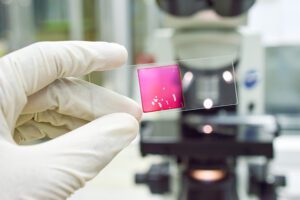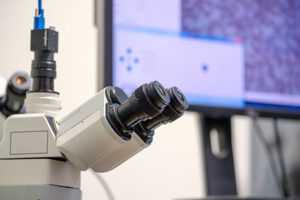The COVID-19 pandemic shook up the healthcare system, and many of the changes that were implemented may stick around and improve healthcare delivery. The pandemic forced pathologists to revisit telehealth and digital pathology tools that allow remote access.
The Pandemic as a Catalyst for Digital Pathology
The pandemic served as a catalyst for pathologists to adopt digital workflows and embrace the advantages of these tools. As a result, the value of digital pathology and remote pathology services is gaining wider acceptance.
 Many pathologists needed a way to work from home due to physical distancing guidelines. Digital pathology platforms allow pathologists to view, analyze, share, and annotate digital slides from their home offices, eliminating delays in diagnosis and treatment. This allows pathologists to work from home and maintain quality patient care standards while minimizing the risk of COVID-19 exposure and spread.
Many pathologists needed a way to work from home due to physical distancing guidelines. Digital pathology platforms allow pathologists to view, analyze, share, and annotate digital slides from their home offices, eliminating delays in diagnosis and treatment. This allows pathologists to work from home and maintain quality patient care standards while minimizing the risk of COVID-19 exposure and spread.
The pandemic also moved certain legislation forward more rapidly. The Centers for Medicare and Medicaid Services (CMS) issued a waiver that allowed pathologists to work remotely. The FDA relaxed some of its guidelines regarding the approval and validation of digital pathology–related technology to allow pathologists to work from home. A study at The Ohio State University found that following the CMS waiver, 60% of pathologists reported using digital pathology for remote primary diagnosis and 85.7% stated that they would continue to use these tools if restrictions were permanently lifted.
AI on the Horizon
Digital pathology enhanced with artificial intelligence (AI) methodologies is gaining acceptance. There are opportunities to use AI for diagnostic workups, particularly in guiding personalized cancer treatments. For pathologists to benefit from AI, they need digitized slides as a starting point. Currently, there are several pathology-oriented AI tools (clinical decision-support algorithms) available to assist pathologists in reviewing cases.
AI, which refers to computers that can “think” and learn, is quickly gaining traction across healthcare. Machine learning (ML) is one type of AI that involves computers with the ability to develop models based on information received without any further programming or interventions. Specific to pathology, ML can aid in the discovery of patterns within images that can be used to make predictions. For example, ML algorithms are currently being used to help pathologists assess H&E stains used in the prognosis of breast cancer and lung carcinoma.2
AI tools can enhance digital imaging by providing faster diagnoses and decreasing labor costs. These tools can augment the workflow, aiding clinical decision support and enhancing care delivery. In the future, AI tools are expected to progress from supporting automated case review to computer-assisted diagnosis.2
 More Successful AI Examples in Pathology
More Successful AI Examples in Pathology
ML and deep learning algorithms can aid pathologists’ decision-making by allowing them to review large amounts of detailed data with computer-level accuracy. The Ohio State University Comprehensive Cancer Center uses digital images as part of their routine diagnostic workflow. They have determined that due to increased productivity and error reduction, the digital pathology system will pay for itself in five years.1 AI tools and digitized images are being used for repetitive tasks like identifying metastases in lymph nodes, grading cancers, and developing biomarker detection tools to help determine which patients will benefit from a particular drug.1
The FDA recently approved an AI software—Paige Prostate—to assist in prostate biopsy review. As an adjunct to pathologist review of digitized prostate biopsy images and to aid in defining the best initial diagnosis, Paige Prostate identifies areas of interest on the images that contain the highest likelihood of cancer for further review.3
While these are exciting endeavors, there are still hurdles ahead before AI technologies are widely used. Implementing digital imaging and AI tools so they function well in daily practice has several challenges that will need to be addressed. For example, to gain pathologist buy-in, AI tools need to be easy to use, be trustworthy, and demonstrate a financial gain.
References
1. Lujan, G.M., Savage, J., Shana’ah, A., et. al. Digital Pathology Initiatives and Experience of a Large Academic Institution During the Coronavirus Disease 2019 (COVID-19) Pandemic. Arch Pathol Lab Med. May 2021, 145 (9): 1051–1061.
2. Zarella, M.D., Bowman, D., Aeffner, F., et al. A practical guide to whole slide imaging: A white paper from the digital pathology association. Archives of Pathology & Laboratory Medicine. 2019; 143 (2): 222–234. https://doi.org/10.5858/arpa.2018-0343-RA
3. Ridley, E.L. FDA clears 1st prostate pathology AI software application. LabPulse.com. September 2021. Accessed at: www.labpulse.com/index.aspx?sec=nws&sub=rad&pag=dis&itemid=802302
